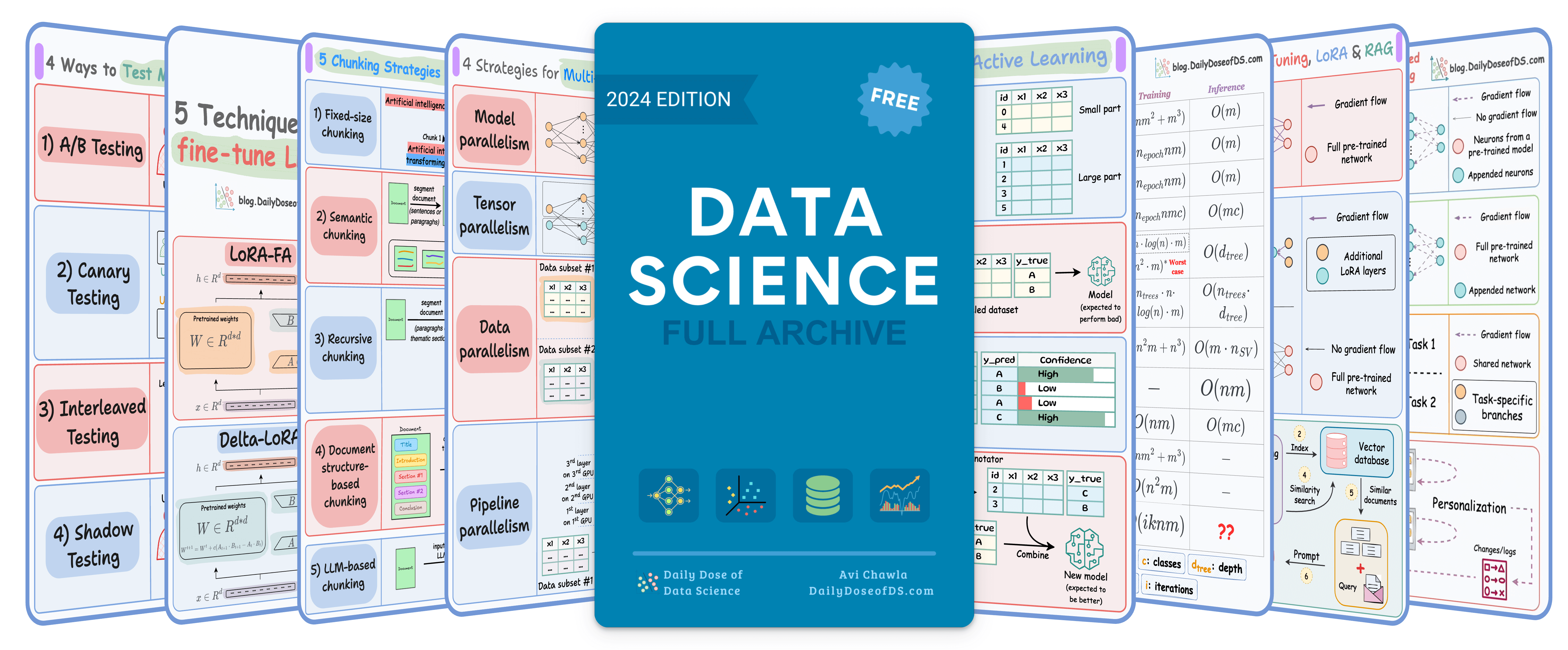

TODAY'S ISSUE
TODAY’S DAILY DOSE OF DATA SCIENCE
Use Box Plots with Caution!
Box plots are pretty common in data analysis.
Yet, they can be highly misleading at times.
Let’s understand how!
To begin, a box plot is a graphical representation of just five numbers:

- min
- first quartile
- median
- third quartile
- max
This means that if two entirely different distributions have similar five values, they will produce identical box plots, as depicted below:

As depicted above, three datasets have the same box plots, but entirely different distributions.
This shows that solely looking at a bar plot may lead to incorrect or misleading conclusions.
Here, the takeaway is not that box plots should not be used.
Instead, the takeaway is that whenever we generate any summary statistic, we lose essential information.
Thus, always look at the underlying data distribution.
For instance, whenever I create a box plot, I create a violin (or KDE) plot too. This lets me validate whether summary statistics resonate with the data distribution.
In fact, I also find Raincloud plots to be pretty useful.

They provide a pretty concise way to combine and visualize three different types of plots together:
- Box plots for data statistics.
- Strip plots for data overview.
- KDE plots for the probability distribution of data.
Impressive, isn't it?
That said…
Building end-to-end projects has taught me MANY invaluable technical lessons and cautionary measures, which I hardly found anyone talking about explicitly.
I covered 8 more pitfalls and cautionary measures here: 8 Fatal (Yet Non-obvious) Pitfalls and Cautionary Measures in Data Science.
Moreover, I have seen that many ML engineers quickly pivot to building a different model when they don't get satisfying results with one kind of model.
They do not fully exploit the possibilities of existing models and continue to move towards complex ones.
However, after building so many ML models, I have learned various techniques that uncover nuances and optimizations we could apply to significantly enhance model performance without necessarily increasing the model complexity.
I shared 11 such high-utility techniques here: 11 Powerful Techniques To Supercharge Your ML Models.
👉 Over to you: What other measures do you take when using summary statistics?
ROADMAP
From local ML to production ML
Once a model has been trained, we move to productionizing and deploying it.
If ideas related to production and deployment intimidate you, here’s a quick roadmap for you to upskill (assuming you know how to train a model):
- First, you would have to compress the model and productionize it. Read these guides:
- Reduce their size with Model Compression techniques.
- Supercharge PyTorch Models With TorchScript.
- If you use sklearn, learn how to optimize them with tensor operations.
- Next, you move to deployment. Here’s a beginner-friendly hands-on guide that teaches you how to deploy a model, manage dependencies, set up model registry, etc.
- Although you would have tested the model locally, it is still wise to test it in production. There are risk-free (or low-risk) methods to do that. Learn what they are and how to implement them here.
This roadmap should set you up pretty well, even if you have NEVER deployed a single model before since everything is practical and implementation-driven.
THAT'S A WRAP
No-Fluff Industry ML resources to
Succeed in DS/ML roles

At the end of the day, all businesses care about impact. That’s it!
- Can you reduce costs?
- Drive revenue?
- Can you scale ML models?
- Predict trends before they happen?
We have discussed several other topics (with implementations) in the past that align with such topics.
Here are some of them:
- Learn sophisticated graph architectures and how to train them on graph data in this crash course.
- So many real-world NLP systems rely on pairwise context scoring. Learn scalable approaches here.
- Run large models on small devices using Quantization techniques.
- Learn how to generate prediction intervals or sets with strong statistical guarantees for increasing trust using Conformal Predictions.
- Learn how to identify causal relationships and answer business questions using causal inference in this crash course.
- Learn how to scale and implement ML model training in this practical guide.
- Learn 5 techniques with implementation to reliably test ML models in production.
- Learn how to build and implement privacy-first ML systems using Federated Learning.
- Learn 6 techniques with implementation to compress ML models.
All these resources will help you cultivate key skills that businesses and companies care about the most.
SPONSOR US
Advertise to 600k+ data professionals
Our newsletter puts your products and services directly in front of an audience that matters — thousands of leaders, senior data scientists, machine learning engineers, data analysts, etc., around the world.





